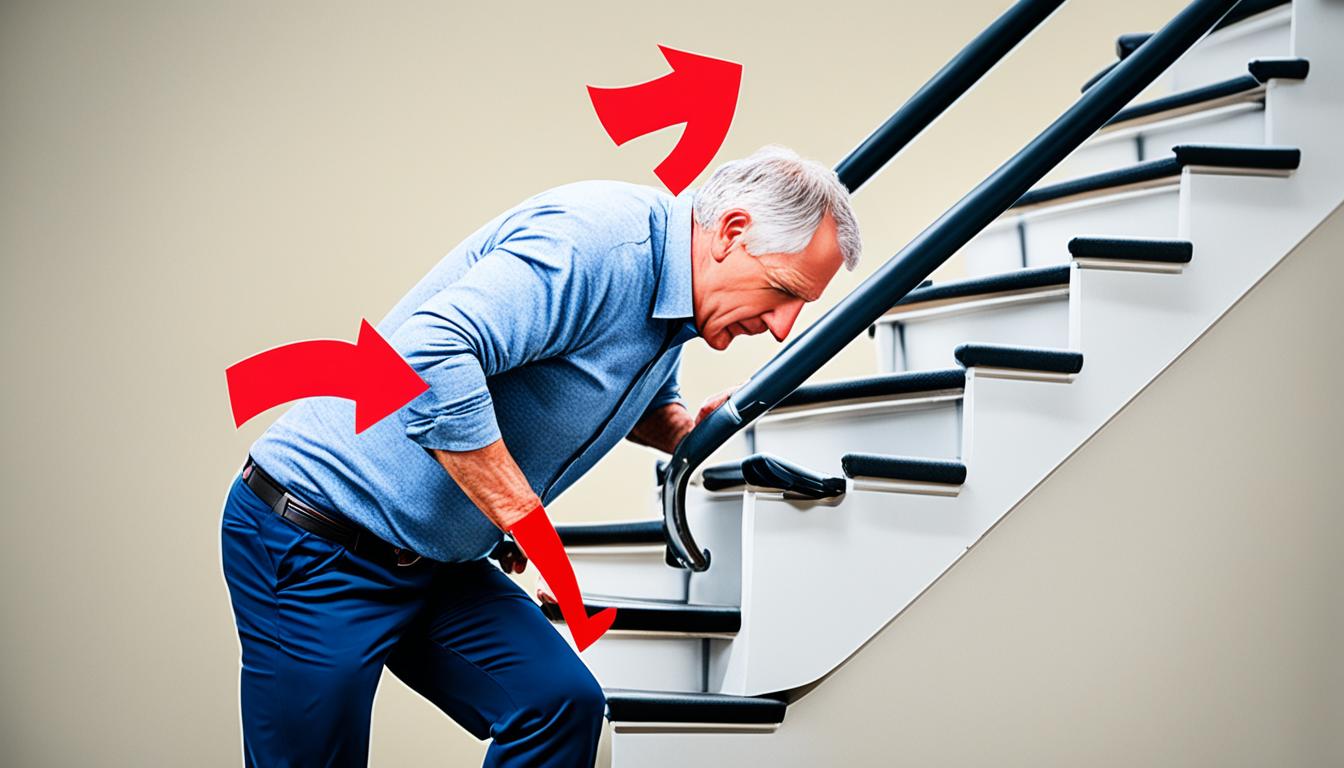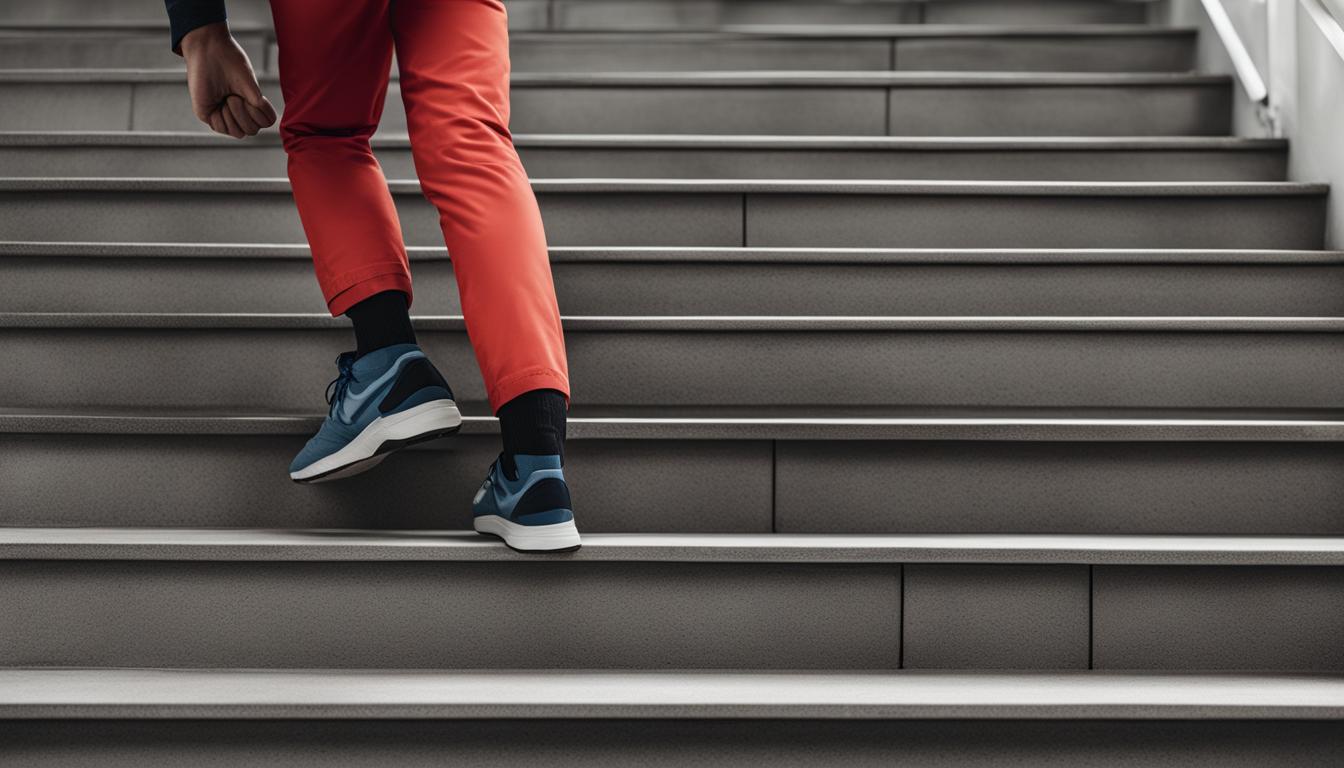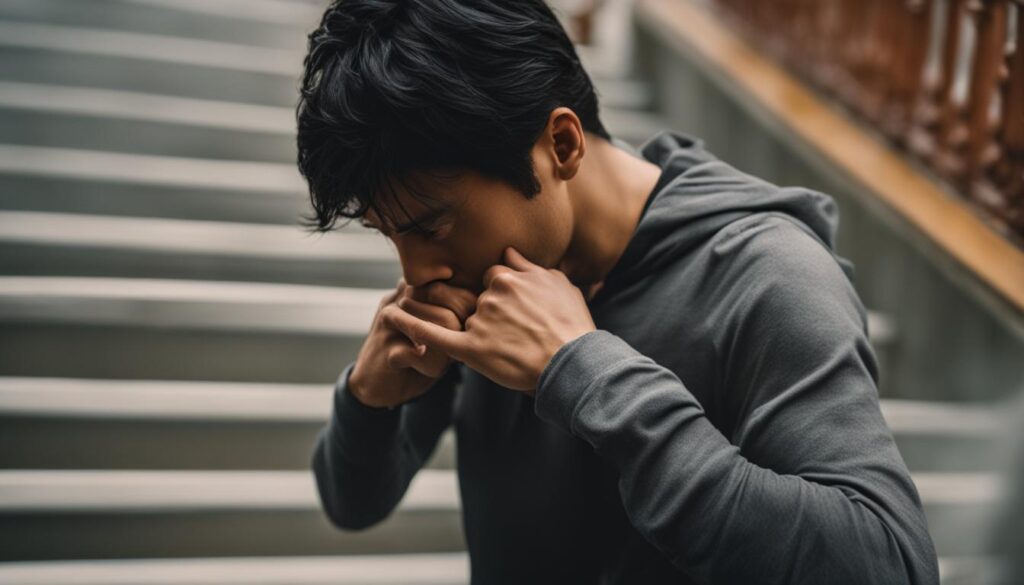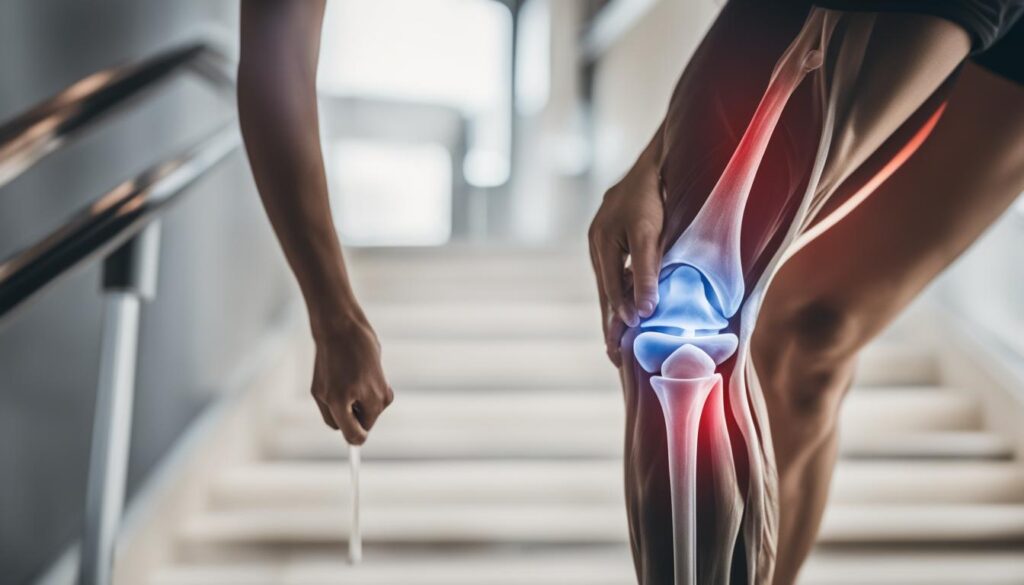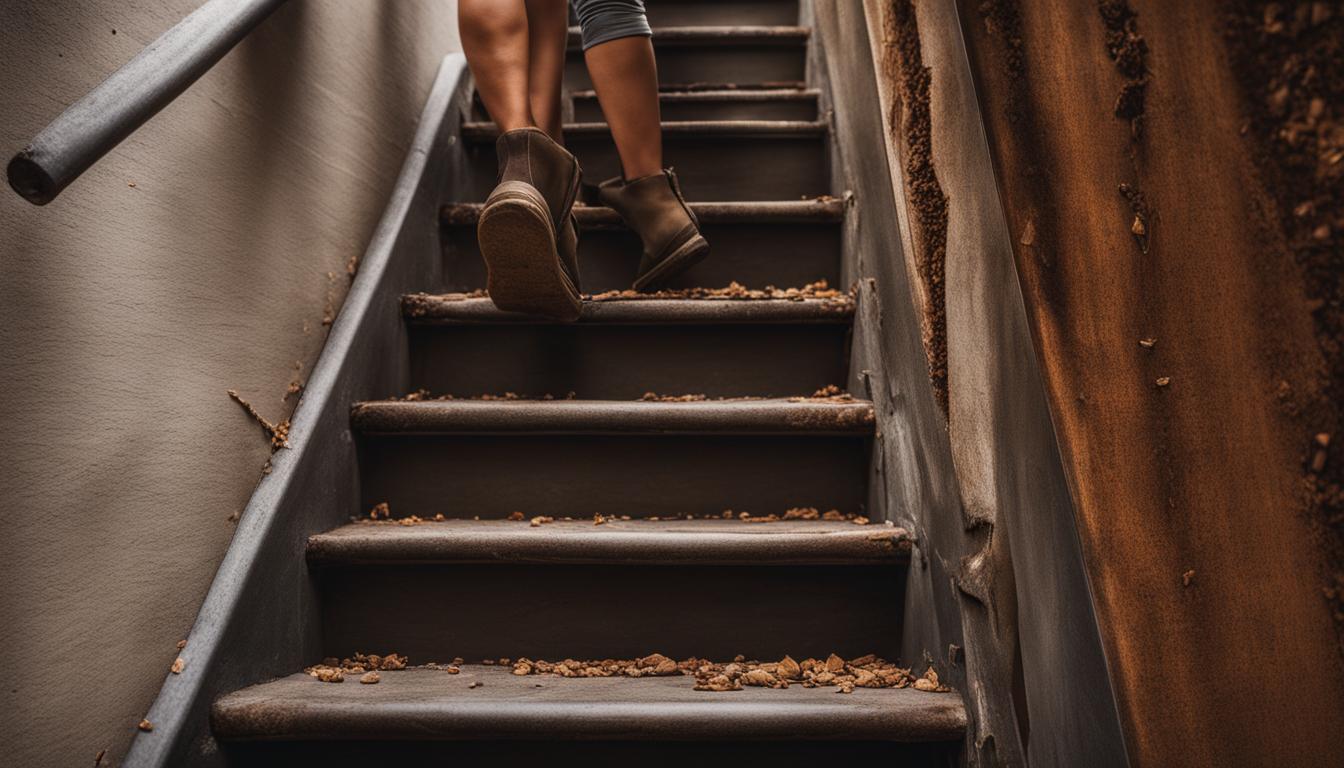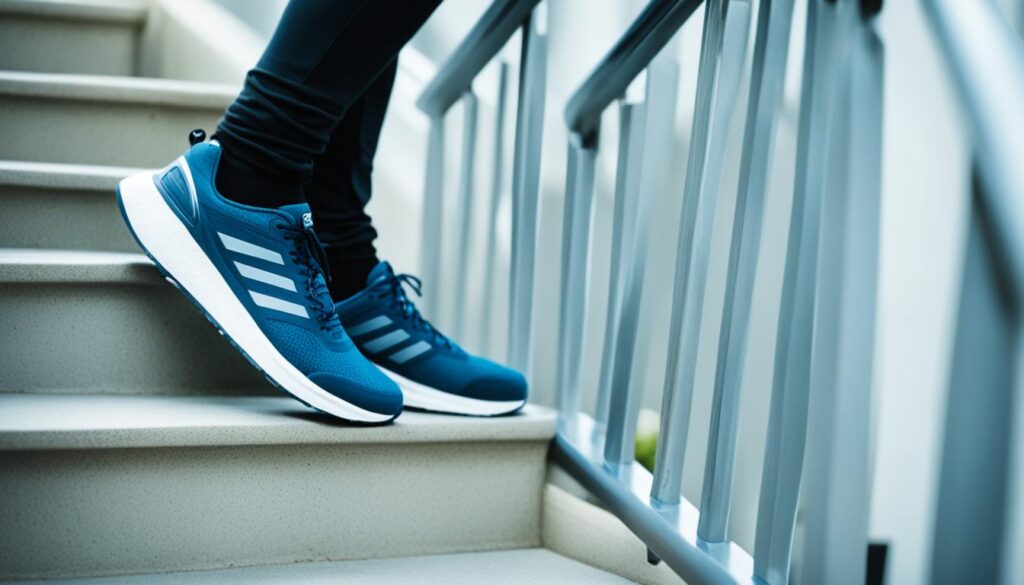If walking around on flat surfaces feels fine but your knees start to ache as soon as you start climbing stairs, you might be wondering what’s going on. While your knees are designed to withstand a lot of pressure, stepping onto a staircase engages different muscles and makes you move at an angle while working against gravity. As you climb, your knees may end up bearing a force that’s anywhere from three to six times your body weight. That extra pressure alone shouldn’t hurt, but if you’ve been doing a lot of stair climbing, have an underlying health condition, or even just turn the wrong way you might find that taking the stairs is suddenly painful.
Key Takeaways:
- Knee pain when climbing stairs can be caused by the additional force exerted on the knees compared to flat surfaces.
- Factors such as repeated stair climbing, underlying health conditions, and incorrect movements can contribute to knee pain on stairs.
- Understanding the anatomy and function of the knee joint can help in comprehending the source of knee pain.
- Common causes of knee pain when climbing stairs include patellofemoral pain syndrome, meniscus tears, chondromalacia patella, IT band syndrome, and muscle imbalances.
- Treatment options for knee pain during stair climbing may include targeted exercises, body awareness, and modification of walking techniques.
Understanding Knee Anatomy and Function
In order to understand knee pain when climbing stairs, it helps to know some basics about what comprises your knee and how this important joint works. The knee joint consists of the patella (kneecap), femur (thigh bone), and tibia (shin bone). Ligaments, tendons, cartilage, menisci, bursae, and muscles all play crucial roles in the stability and movement of the knee. Nerves in the knee transmit pain signals to the brain, allowing us to feel any discomfort or pain that may arise.
Here is an overview of the key components of the knee:
| Component | Function |
|---|---|
| Ligaments | Provide stability by connecting bones and preventing excessive movement. |
| Tendons | Attach muscles to bones, allowing for joint movement. |
| Cartilage | Acts as a cushion between the bones, reducing friction and absorbing shock. |
| Menisci | Provide additional cushioning and help with load distribution. |
| Bursae | Small fluid-filled sacs that reduce friction between tissues. |
| Muscles | Help with movement and provide support to the knee joint. |
| Nerves | Transmit pain signals to the brain, allowing us to feel any discomfort or pain. |

Common Causes of Knee Pain When Climbing Stairs
When it comes to knee pain while climbing stairs, there are several common causes that may be to blame. Understanding these causes can help you identify the source of your discomfort and seek appropriate treatment. Let’s explore some of the key contributors:
- Patellofemoral Pain Syndrome (Runner’s Knee): This condition often manifests as pain in the front of the knee and is linked to overuse or increased physical activity. Running, jumping, and activities that repeatedly stress the knee joint can lead to this syndrome.
- Meniscus Tear: A tear in the meniscus, which is the C-shaped cartilage in the knee, can occur due to sudden twisting or normal age-related changes. This tear can cause pain on the inner or outer aspect of the knee, making stair climbing uncomfortable.
- Chondromalacia Patella: Chondromalacia patella refers to the softening and deterioration of the cartilage on the underside of the kneecap. This condition can result in irritation or a dull ache when flexing the knee, including when climbing stairs.
- IT Band Syndrome: IT band syndrome is characterized by inflammation and rubbing of the iliotibial (IT) band, which runs along the outside of the thigh and knee. This syndrome can contribute to pain on the outside of the knee, particularly when descending stairs.
- Muscle Imbalance: Muscle imbalances, particularly quad dominance, can also lead to knee pain when climbing stairs. Weak or tight muscles around the knee can disrupt the proper alignment and functioning of the joint, resulting in discomfort.
By understanding these common causes, you can better determine the potential underlying issue contributing to your knee pain when climbing stairs. Remember, it’s always advisable to consult with a healthcare professional for an accurate diagnosis and personalized treatment plan.

| Cause | Symptoms | Treatment |
|---|---|---|
| Patellofemoral Pain Syndrome (Runner’s Knee) | Pain in the front of the knee; worsens with activity; often accompanied by a grinding sensation | – Rest and avoid activities that aggravate the condition – Physical therapy to strengthen surrounding muscles – Use of knee braces or supportive tape – Anti-inflammatory medication for pain management |
| Meniscus Tear | Pain on the inner or outer aspect of the knee; swelling; limited range of motion | – Rest and avoid activities that worsen symptoms – Physical therapy to restore strength and flexibility – Possible surgical repair or removal of the torn meniscus |
| Chondromalacia Patella | Dull aching pain beneath the kneecap; worsens with activities that involve knee flexion | – Rest and avoid activities that exacerbate symptoms – Physical therapy to improve muscle strength and flexibility – Use of knee sleeves or braces for support – Regenerative treatments such as platelet-rich plasma (PRP) therapy |
| IT Band Syndrome | Pain on the outside of the knee; worsens with activities that involve knee flexion or extension | – Rest and avoid activities that aggravate the condition – Stretching and foam rolling to release tension in the IT band – Physical therapy to address muscle imbalances and strengthen surrounding muscles – Use of knee straps to alleviate pressure on the IT band |
| Muscle Imbalance | Weakness or tightness in specific muscle groups around the knee; altered knee alignment | – Comprehensive physical therapy to correct muscle imbalances – Specific exercises to strengthen weak muscles and stretch tight muscles – Modification of training regimen to promote balanced muscle development |
Treatment Options for Knee Pain During Stair Climbing
When it comes to managing knee pain during stair climbing, there are various treatment options that can bring relief and support your long-term joint health. Targeted exercises, body awareness, and modifying your walking technique can all play a significant role in reducing knee pain and improving your overall comfort. It’s important to remember that consulting with a healthcare provider or physical therapist is key to finding the most appropriate treatment approach tailored to your individual needs.
Targeted Exercises
One effective way to address knee pain during stair climbing is through targeted exercises that strengthen the structures surrounding your knees. Engaging in regular hip flexor stretches can help to increase flexibility and reduce tension on the knees. Single-leg lifts and hamstring stretches can also aid in alleviating pain as they target specific muscles groups responsible for supporting knee movement.
Here are a few targeted exercises to consider:
- Hip flexor stretches
- Single-leg lifts
- Hamstring stretches
Body Awareness and Modification of Walking Technique
In addition to targeted exercises, having body awareness and modifying your walking technique can contribute to reducing knee pain during stair climbing. By engaging your glutes and hamstrings while climbing, you can distribute the workload more evenly across your leg muscles. Adjusting your posture and focusing on different muscle groups can also help to alleviate knee pain and promote proper movement mechanics.
Consultation with Healthcare Provider or Physical Therapist
While these treatment options can provide valuable support and relief, it’s crucial to consult with a healthcare provider or physical therapist to determine the best course of action for your specific situation. They can provide personalized guidance, assess any underlying causes of your knee pain, and recommend additional treatments or modifications to your exercises for optimal results.
By incorporating targeted exercises, improving body awareness, and seeking professional advice, you can find effective strategies to manage knee pain when climbing stairs and enhance your overall joint health.
| Treatment Options for Knee Pain During Stair Climbing | Description |
|---|---|
| Targeted Exercises | Engage in exercises that strengthen the structures in and around the knees, such as hip flexor stretches, single-leg lifts, and hamstring stretches. |
| Body Awareness and Modification of Walking Technique | Focus on engaging glutes and hamstrings, adjusting posture, and targeting different muscle groups while climbing stairs. |
| Consultation with Healthcare Provider or Physical Therapist | Seek professional advice to receive personalized guidance and determine the most suitable treatment approach based on individual needs. |
Prevention Tips for Knee Pain When Climbing Stairs
Taking preventive measures can help reduce the risk of knee pain when climbing stairs. Here are some tips to keep your knees healthy:
- Maintain a healthy weight: Excess body weight puts extra pressure on your knees. By maintaining a healthy weight, you can alleviate stress and reduce the risk of knee pain.
- Engage in low-impact exercises: Instead of high-impact activities like running or jumping, opt for low-impact exercises such as cycling or swimming. These exercises help strengthen muscles without putting excessive strain on the knees.
- Use knee pads: If you engage in activities that involve kneeling or impact, using knee pads can provide cushioning and protection, reducing the risk of knee injuries.
- Wear proper footwear with arch support: Choosing footwear that offers proper arch support can promote proper alignment and reduce stress on the knee joints.
- Strengthen leg muscles: Strengthening the muscles around your knees can help absorb and distribute forces, reducing the strain on the knee joints. Include exercises like squats, lunges, and leg presses in your workout routine.
- Warm up and cool down: Before and after physical activity, it’s important to warm up and cool down. Perform dynamic stretches to warm up your muscles and joints, and then do static stretches to cool down and prevent stiffness.
Maintaining a healthy weight, engaging in low-impact exercises, using knee pads, wearing proper footwear with arch support, strengthening leg muscles, and warming up and cooling down are all effective preventive measures to reduce the risk of knee pain when climbing stairs.
“Prevention is the key to maintaining healthy knees. By adopting these tips, you can keep your knees strong and pain-free, allowing you to conquer any staircase with confidence.”
Comparison of Low-Impact Exercises for Knee Health
| Exercise | Benefits |
|---|---|
| Cycling | Strengthens leg muscles, improves cardiovascular fitness, and minimizes impact on knees |
| Swimming | Builds overall body strength, increases flexibility, and provides low-impact resistance |
| Elliptical training | Offers a full-body workout, improves balance, and reduces stress on knee joints |
| Yoga | Enhances flexibility, strengthens muscles, promotes joint stability, and improves body awareness |
Conclusion
Knee pain when climbing stairs can be a debilitating condition that affects many individuals. By understanding the underlying causes of this pain, we can take the necessary steps towards finding relief and effectively managing our knee health. Targeted exercises, modifications in walking technique, and body awareness can significantly alleviate knee pain and provide relief. These strategies strengthen the muscles and structures around the knee joint, promoting better stability and reducing discomfort.
In addition to exercise, preventive measures play a crucial role in maintaining good joint health and reducing the risk of knee pain. By maintaining a healthy weight, engaging in low-impact exercises, using knee pads during high-impact activities, and wearing proper footwear with adequate arch support, we can minimize stress on the knee joint and promote better alignment. Strengthening leg muscles through exercises helps provide necessary support and stability, further reducing the risk of knee pain.
It is important to remember that each individual’s knee pain is unique, and seeking guidance from healthcare providers and physical therapists is essential. They can provide personalized advice and treatment plans based on the specific needs of the individual. Remember, the goal is not just to find knee pain relief but also to manage and maintain joint health for a better quality of life.
FAQ
Why do I feel pain in my knee while climbing stairs?
Knee pain while climbing stairs can be caused by various factors, including structural issues, overuse, injuries, and muscle imbalances. It may be due to conditions such as patellofemoral pain syndrome, runner’s knee, meniscus tear, chondromalacia patella, or IT band syndrome. Consulting with a healthcare provider can help determine the underlying cause and appropriate treatment options.
How can I relieve knee pain when climbing stairs?
There are several ways to relieve knee pain when climbing stairs. Targeted exercises that strengthen the structures in and around the knees, along with modifications in walking technique and body awareness, can provide relief. It is recommended to consult with a healthcare provider or physical therapist to determine the most suitable treatment approach based on individual needs.
What can I do to prevent knee pain when climbing stairs?
To prevent knee pain when climbing stairs, it is important to maintain a healthy weight to alleviate stress on the knees. Engaging in low-impact exercises, such as cycling or swimming, can strengthen muscles without excessive strain. Using knee pads during activities that involve kneeling or impact can provide cushioning and protection. Wearing proper footwear with arch support can promote proper alignment and reduce knee joint stress. Strengthening leg muscles through exercises can help absorb and distribute forces on the knee. Additionally, warming up and cooling down before and after physical activity can help prepare the muscles and joints and reduce the risk of knee pain.
